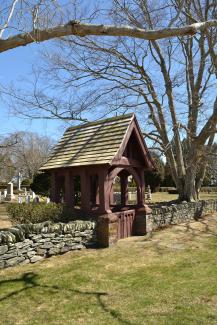A Chapel in Paradise: St. Columba's Listed in National Register of Historic Places
Published on Thursday, August 18, 2022
(Middletown, R.I.) A historic church and churchyard in Middletown have received federal recognition for their contributions to the history of architecture, art, and community development. Jeffrey Emidy, Interim Executive Director of the Rhode Island Historical Preservation & Heritage Commission, announced that the National Park Service has listed St. Columba’s, the Berkeley Memorial Chapel, in the National Register of Historic Places. The National Register is the Federal Government’s official list of properties throughout the United States whose historical and architectural significance makes them worthy of preservation. Constructed in 1884-86, St. Columba’s Chapel is an excellent example of the English Gothic Revival style, and the building and cemetery showcase the work of prominent architects and designers. The property is also significant for its role in Middletown’s development as a summer resort community at the turn of the century.
Middletown's bucolic landscape began to attract summer residents as early as the 18th century. By the mid-19th century, several country estates had been established in the eastern part of town, known as “Paradise.” Eugene Sturtevant of Boston rented a home in the area in 1871 and saw a development opportunity. He purchased local farmland, laid out Indian Avenue, and platted 100 house lots.
By the early 1880s, summer residents were working with the Episcopal Diocese on plans for a mission church in Paradise. Sturtevant and his wife, Mary Clark Sturtevant (daughter of the Bishop of the Episcopal Diocese of Rhode Island) provided a 1.4-acre lot at the intersection of Vaucluse Avenue and Indian Avenue. Members of the Indian Avenue community and a number of Newporters provided funding towards the project and several local farmers made their contribution by digging the chapel’s foundation. The first services were held at the chapel in June 1885, one year before construction was complete.
St. Columba’s, the Berkeley Memorial Chapel, drew its name from two sources. The building was dedicated to St. Columba, an Irish missionary credited with bringing Christianity to Scotland. And it honors the memory of Anglo-Irish philosopher George Berkeley (also known as Bishop Berkeley) who lived in a farmhouse two miles east of St. Columba’s between 1729 and 1731.
The chapel has exterior walls of rough-cut schist and granite and a steeply-pitched, slate-shingled, gable roof. A series of stone buttresses are situated along the window bays and at the corners of the chapel. The principal entry is located in a gable-roof porch. The interior walls are also of stone, floors are wood plank, and the vaulted ceiling is supported by decorative trusses and finished in tongue-and-groove wood sheathing.
The design of St. Columba’s was an early commission for architect Wilson Eyre, Jr. (1858-1944). Born in Florence, Italy and raised in Philadelphia, Eyre had ties to Newport, where his family spent summers and he attended boarding school. Eyre trained for one year at the Massachusetts Institute of Technology before joining a Philadelphia architectural firm in 1877. ‘His only other surviving Rhode Island project is a summer home known as "Anchorage" in Watch Hill (1913-14).
The chapel features a number of memorial stained-glass windows designed by noted artist D. Maitland Armstrong (1836-1918). A former summer resident of Newport and Paradise Valley, he practiced law before becoming a painter and then a stained-glass designer in the 1880s. The 14 windows he designed for St. Columba’s in 1885-86 were manufactured by the Tiffany Company of New York. The design and manufacture of the large stained-glass window in the west elevation (installed in 1885) is attributed to the Belcher Mosaic Glass Company of New York City and Newark.
The property also includes a historic burying ground with many stones carved by John Howard Benson, John Everett Benson, and Nicholas Benson of the John Stevens Shop in Newport. Another notable work of funerary art is the Art Moderne-style marker for the grave of filmmaker Varick Frissell (1903-1931) by sculptor Gerome Brush. The perimeter of the property is encircled by stone walls with a cypress-and-stone, Gothic Revival-style lych gate south of the chapel entrance. Common in England, lych gates provide a sheltered spot for the priest to receive the casket before a funeral service. Designed by Boston architect Henry Vaughan (1845-1917), this structure was dedicated in memory of Indian Avenue summer residents Reverend Henry A. Coit and his wife, Mary in 1897.
“St Columba’s is a living, evolving community of faith, a 21st-century congregation with enormous respect for its history, and I’m proud of the way that generations of hard-working parishioners have cared for this beautiful chapel and churchyard,” said Rev. Anne Bolles-Beaven, the rector of St. Columba’s. “It is an honor to have this property placed on the National Register, and we are grateful to the RIHPHC and Architectural Historian Joanna Doherty for making that possible. The recognition comes at an important moment in our efforts to preserve this legacy for future generations.”
RIHPHC’s Interim Executive Director Jeffrey Emidy added, “St. Columba’s is a beautiful property with an important place in the history of Middletown. The congregation has done a wonderful job preserving the church, cemetery, and grounds for over 140 years and we congratulate and thank them for their dedication.”
The National Register documentation was prepared by RIHPHC Architectural Historian Joanna Doherty. In addition to honoring a property for its contribution to local, state, or national history, listing on the National Register provides additional benefits. It results in special consideration during the planning of Federal or federally assisted projects and makes properties eligible for Federal and Rhode Island tax benefits for historic rehabilitation projects. Owners of private property listed on the National Register are free to maintain, manage, or dispose of their property as they choose. As the state office for historic preservation, the RIHPHC is responsible for reviewing and submitting Rhode Island nominations to the National Register. The nomination for St. Columba's is available on the RIHPHC website, www.preservation.ri.gov.
